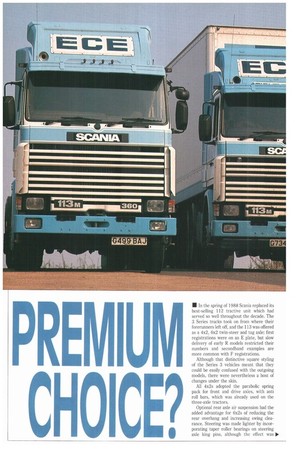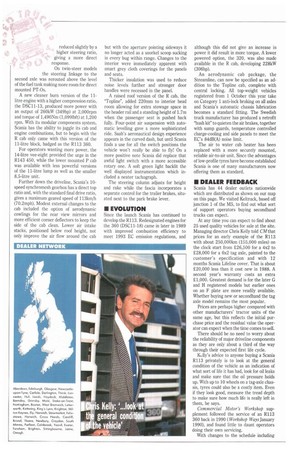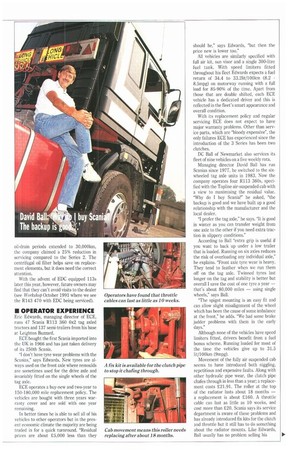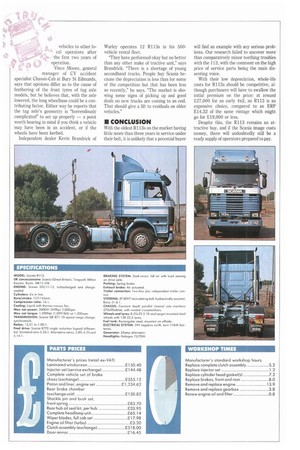P R E MIUM CH OI CE
Page 32

Page 34

Page 35

Page 36

If you've noticed an error in this article please click here to report it so we can fix it.
. In the spring of 1988 Scania replaced its best-selling 112 tractive unit which had served so well throughout the decade. The 3 Series trucks took on from where their forerunners left off, and the 113 was offered as a 4x2, 6x2 twin-steer and tag axle: first registrations were on an E plate, but slow delivery of early R models restricted their numbers and secondhand examples are more common with F registrations.
Although that distinctive square styling of the Series 3 vehicles meant that they could be easily confused with the outgoing models, there were nevertheless a host of changes under the skin.
All 4x2s adopted the parabolic spring pack for front and drive axles, with anti roll bars, which was already used on the three-axle tractors.
Optional rear axle air suspension had the added advantage for 6x2s of reducing the rear overhang and increasing swing clearance. Steering was made lighter by incorporating taper roller bearings on steering axle king pins, although the effect was Po reduced slightly by a higher steering ratio, giving a more direct response.
On twin-steer models the steering linkage to the second axle was rerouted above the level of the fuel tank making more room for direct mounted PT-Os.
A new cleaner burn version of the 11litre engine with a higher compression ratio, the DSC11-13, produced more power with an output of 260kW (349hp) at 2,000rpm and torque of 1,490Nm (1,0991bft) at 1,200 rpm. With its modular components system, Scania has the ability to juggle its cab and engine combinations, but to begin with the R cab only came with this version of the 11-litre block, badged as the R113 360.
For operators wanting more power, the 14-litre vee-eight provided the urge in the R143 450, while the lower mounted P cab was available with less powerful versions of the 11-litre lump as well as the smaller 8.5-litre unit.
Further down the driveline, Scania's 10speed synchromesh gearbox has a direct top ratio and, with the standard final drive ratio, gives a maximum geared speed of 113km/h (70.2mph). Modest external changes to the cab included the option of aerodynamic cowlings for the rear view mirrors and more efficient corner deflectors to keep the side of the cab clean. Lower air intake stacks, positioned below roof height, not only improve the air flow around the cab but with the aperture pointing sideways it no longer acted as a snorkel scoop sucking in every bug within range. Changes to the interior were immediately apparent with smart grey cloth coverings for the panels and seats.
Thicker insulation was used to reduce noise levels further and stronger door handles were recessed in the panel.
A raised roof version of the R cab, the "Topline", added 220mm to interior head room allowing for extra stowage space in the header rail and a standing height of 1.7m when the passenger seat is pushed back fully. Four-point air suspension with automatic levelling gave a more sophisticated ride. Saab's aeronautical design experience appears in the curved dash, but until Scania finds a use for all the switch positions the vehicle won't really be able to fly! On a more positive note Scania did replace that awful light switch with a more accessible rotary one. A soft green light backlit the well displayed instrumentation which included a neater tachograph.
The steering column adjusts for height and rake while the fascia incorporates a separate control for the trailer brakes, situated next to the park brake lever.
• EVOLUTION
Since the launch Scania has continued to develop the R113. Redesignated engines for the 360 (DSC11-18) came in later in 1989 with improved combustion efficiency to meet 1993 EC emission regulations, and although this did not give an increase in power it did result in more torque. A lower powered option, the 320, was also made available in the R cab, developing 228kW (306hp).
An aerodynamic cab package, the Streamline, can now be specified as an addition to the Topline cab, complete with central locking. All top-weight vehicles registered from 1 October this year take on Category 1 anti-lock braking on all axles and Scania's automatic chassis lubrication becomes a standard fitting. The Swedish truck manufacturer has produced a retrofit "hush kit" to quieten the air brakes, together with sump guards, temperature controlled charge-cooling and side panels to meet the EC's 84dB(A) noise limit.
The air to water cab heater has been replaced with a more securely mounted, reliable air-to-air unit. Since the advantages of low-profile tyres have become established Scania is one of many manufacturers now offering them as standard.
• DEALER FEEDBACK
Scania has 44 dealer outlets nationwide which are distributed as shown on our map on this page. We visited Keltruck, based off junction 1 of the M5, to fmd out what sort of support operators buying secondhand trucks can expect.
At any time you can expect to find about 25 used quality vehicles for sale at the site_ Managing director Chris Kelly told CM that prices for an early example of the R113 with about 250,000km (155,000 miles) on the clock start from £26,500 for a 4x2 to £28,000 for a 6x2 tag axle, painted to the customer's epecification and with 12 months Scania Lifeline cover. That is about £20,000 less than it cost new in 1988. A second year's warranty costs an extra £1,000. Greatest demand is for the later G and H registered models but earlier ones on an F plate are more readily available. Whether buying new or secondhand the tag axle model remains the most popular.
Prices are perhaps higher compared with other manufacturers' tractor units of the same age, but this reflects the initial purchase price and the residual value the operator can expect when the time comes to sell.
There should be no need to worry about the reliability of major driveline components as they are only about a third of the way through their expected first life cycle.
Ktly's advice to anyone buying a Scania R113 privately is to look at the general condition of the vehicle as an indication of what sort of life it has had, look for oil leaks and make sure that the oil pressure holds up. With up to 10 wheels on a tag-axle chassis, tyres could also be a costly item. Even if they look good, measure the tread depth to make sure how much life is really left in them, he says.
Commercial Motor's Workshop supplement followed the service of an R113 360 back in 1990 (Workshop WaysJanuary 1990), and found little to daunt operators doing their own servicing.
With changes to the schedule including oil-drain periods extended to 30,000km, the company claimed a 25% reduction in servicing compared to the Series 2. The centrifugal oil filter helps save on replacement elements, but it does need the correct attention.
With the advent of EDC equipped 113s later this year, however, future owners may find that they can't avoid visits to the dealer (see Workshop October 1991 where we see the R143 470 with EDC being serviced).
• OPERATOR EXPERIENCE
Eric Edwards, managing director of ECE, runs 47 Scania R113 360 6x2 tag axled tractors and 137 semi-trailers from his base at Leighton Buzzard.
ECE bought the first Scania imported into the UK in 1966 and has just taken delivery of its 250th Scania.
"I don't have tyre wear problems with the Scanias," says Edwards. New tyres are always used on the front axle where remoulds are sometimes used for the drive axle and invariably fitted on the single wheels of the tag axle.
ECE operates a buy-new and two-year to 150-180,000 mile replacement policy. The vehicles are bought with three years warranty cover and are sold with one year remaining.
In better times he is able to sell all of his vehicles to other operators but in the present economic climate the majority are being traded in for a quick turnround. "Residual prices are about £5,000 less than they
should be," says Edwards, "but then the price new is lower too."
All vehicles are similarly specified with full air kit, sun visor and a single 300-litre fuel tank. With speed limiters fitted throughout his fleet Edwards expects a fuel return of 34.4 to 33.21it/100km (8.2 8.5mpg) on motorway running with a full load for 85-90% of the time. Apart from those that are double shifted, each ECE vehicle has a dedicated driver and this is reflected in the fleet's smart appearance and overall condition.
With its replacement policy and regular servicing ECE does not expect to have major warranty problems. Other than service parts, which are "bloody expensive", the only failures ECE has experienced since the introduction of the 3 Series has been two clutches.
DC Ball of Newmarket also services its fleet of nine vehicles on a five weekly rota.
Managing director David Ball has run Scanias since 1977, he switched to the sixwheeled tag axle units in 1983. Now the company operates four R113 360s, specified with the Topline air-suspended cab with a view to maximising the residual value. "Why do I buy Scania?" he asked, "the backup is good and we have built up a good relationship with the manufacturer and the local dealer.
"I prefer the tag axle," he says. "It is good in winter as you can transfer weight from one axle to the other if you need extra traction in slippery conditions."
According to Ball "extra grip is useful if you want to back up under a low trailer that is loaded. Running on six axles reduces the risk of overloading any individual axle," he explains. "Front axle tyre wear is heavy. They tend to feather when we run them off on the tag axle. Twinned tyres last longer on the tag and stability is better but overall I save the cost of one tyre a year — that's about 80,000 miles — using single wheels," says Ball.
"The spigot mounting is an easy fit and can allow slight misalignment of the wheel which has been the cause of some imbalance at the front," he adds. "We had some brake judder problems with them in the early days."
Although none of the vehicles have speed limiters fitted, drivers benefit from a fuel bonus scheme. Running loaded for most of the time the vehicles give up to 31.5 lit/100km (9mpg).
Movement of the fully air suspended cab seems to have introduced both niggling, repetitious and expensive faults. Along with other hydraulic pipe wear, the clutch pipe chafes through in less than a year; a replacement costs £21.91. The roller at the top of the radiator lasts about 18 months — a replacement is about £160. A throttle cable can last as little as 10 weeks, and cost more than £20. Scania says its service department is aware of these problems and has already introduced fix kits for the clutch and throttle but it still has to do something about the radiator mounts. Like Edwards, Ball usually has no problem selling his vehicles to other local operators after the first two years of operation.
Vince Moore, general manager of CV accident specialist Chassis-Cab at Bury St Edmunds, says that opinions differ as to the cause of feathering of the front tyres of tag axle models, but he believes that, with the axle lowered, the long wheelbase could be a contributing factor. Either way he reports that the tag axle's geometry is "horrendously complicated" to set up properly — a point worth bearing in mind if you think a vehicle may have been in an accident, or if the wheels have been kerbed.
Independent dealer Kevin Brandrick of Warley operates 12 R113s in his 500vehicle rental fleet.
"They have performed okay but no better than any other make of tractive unit," says Brandrick, "There is a shortage of young secondhand trucks. People buy Scania because the depreciation is less than for some of the competition but that has been less so recently," he says. "The market is showing some signs of picking up and good deals on new trucks are coming to an end. That should give a lift to residuals on older vehicles."
• CONCLUSION
With the oldest R113s on the market having little more than three years in service under their belt, it is unlikely that a potential buyer will find an example with any serious problems. Our research failed to uncover more than comparatively minor teething troubles with the 113, with the comment on the high price of service parts being the main dissenting voice.
With their low depreciation, whole-life costs for R113s should be competitive, although purchasers will have to swallow the initial premium on the price: at around £27,000 for an early 4x2, an R113 is an expensive choice, compared to an ERF E14.32 of the same vintage which might go for £19,000 or less.
Despite this, the R113 remains an attractive buy, and if the Scania image costs money, there will undoubtedly still be a ready supply of operators prepared to pay.
















































































































